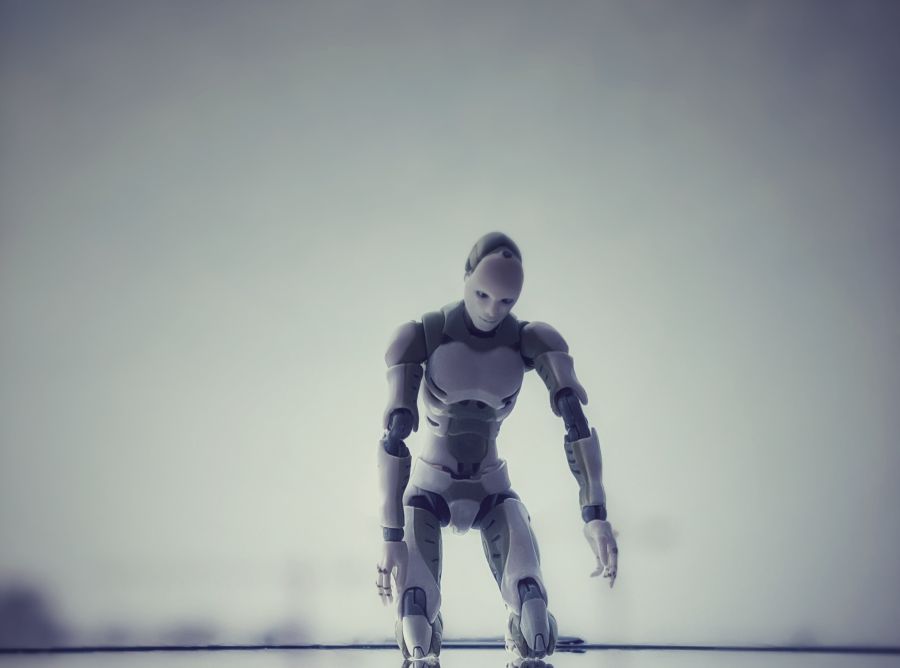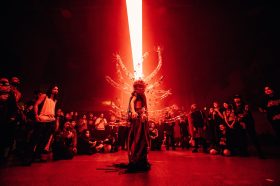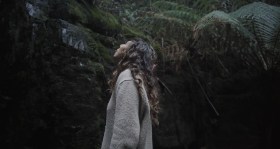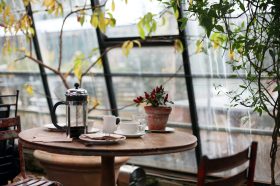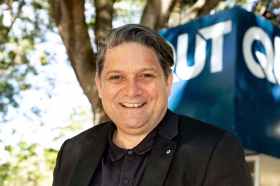The idea that AI (artificial intelligence) machines may one day upend the world was a thought once largely confined to geek circles and science fiction groups. But AI is now driving mainstream headlines and spurring a range of regular conversations across generations.
From doomsday scenarios full of anarchic AI systems to calls for calm amid the media hype – our talk is prompting questions about how this technology may soon make us or break us as a human race. But, on the flip side, AI is opening interesting new avenues of creative exploration for artists.
So, how are Australian artists feeling about this epic new world?
ArtsHub asks a range of practitioners how they are responding to this AI-tsunami, and whether AI is their friend or foe.
AI = friend for visual artist Sam Leach
Sam Leach is one of Australia’s leading contemporary artists. As he is a painter who works primarily with oils, it’s somewhat curious that he’s embraced a medium at the absolute opposite end of the spectrum. Since 2019, Leach has used specially designed AI software as the main creative prompt for his paintings.
‘The process I use draws on a data set comprising images of my previous works,’ he explains. ‘Initially, my goal was to ask it what I should paint next, and have it as a logical progression of what my previous paintings were.’
Over the past three years, Leach says these AI systems have transformed his practice and allowed him unprecedented levels of mental space.
Read: Who owns AI copyright?
‘It just means instead of coming into the studio each day and scratching my head and doing all that cognitive work about what I’m going to paint, I can just get on with the painting.
‘The process feels a lot less weighty, more playful and more intuitive, which has been an unanticipated benefit,’ he says.
‘I also really love the ambiguity of the images my AI program generates – it’s a lot different to using DALL-E or one of the generic AI image generators. I’ve programmed something that is far more bespoke to my own practice.’
AI = foe for visual artist Luke Cornish
Unlike Leach, visual artist Luke Cornish isn’t inclined towards AI to assist his practice, but he also doesn’t see it as fatal to his creative existence.
‘All that AI serves to do, as any new technology, is to provide convenience,’ he says. ‘And while it can’t actively use a can of spray paint, I don’t feel particularly threatened by it.’
While largely unconcerned about AI’s effects on his work as an artist, he does express worry about the fate of the wider world in its hands. ‘My prediction is that, if not regulated early, AI will ultimately render the majority of humanity obsolete, further widening the gap between rich and poor to a dystopian proportion, ushering in an inevitable apocalypse.
‘It will certainly be an exciting ride to see where it goes,’ he concludes.
AI = “frenemy” for artists Karen ann Donnachie and Andy Simionato
For artists Karen ann Donnachie and Andy Simionato AI plays a large role in their practice, which spans everything from electronic art and robotics to graphic design and typography.
As seen in one of their latest works, AI is both friend and foe for this duo.
For their recent cover design for Art + Australia magazine, the artists used DALL-E/AI software to generate images according to their requests for “oil-painted Australian landscape” images, which they then programmatically inserted as “flats” in a VR (virtual reality) theatre set.
The resulting collage, they say, ‘serves as a metaphor for the complexities and contradictions of representing the world as a virtual experience in an age of post-colonialism’ – in a clever take on some of the pointier questions raised by AI’s logic.
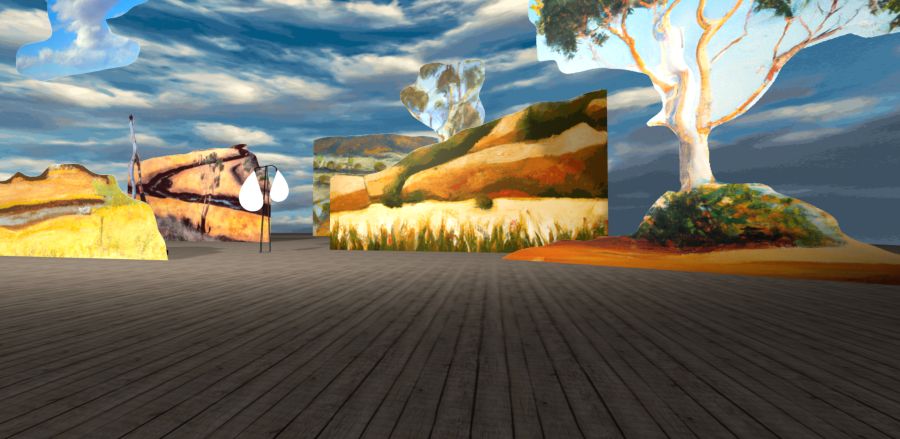
Donnachie and Simionato explain that, as new media practitioners who routinely work with various forms of LLM (large language models), NLP (natural language processing) and what they amusingly refer to as GOFAI (good old-fashioned AI), their works involve questioning and subverting, and they don’t feel particularly overwhelmed by AI’s latest strides. They do, however, harbour some concerns.
‘We don’t want to diminish the latest breakthroughs,’ Simionato says. ‘But a lot of what we are seeing recently is clearly hypey tech-talk.
‘The real question for us has always been about what the role of the human is in this so-called age of AI, as a reflection of the priorities and values of the contemporary societies that created it, and those who will ultimately consume and profit from it,’ he continues.
‘We feel it will continue to serve these specific interests, reinforcing hegemonies, which ultimately benefit a select few, while possibly exacerbating inequalities and even harming others.’
AI = friend for visual artist Sue Beyer
Sue Beyer is an artist who also works closely with computers and technology.
‘Ever since I was 15, when we started to use an Apple II computer for maths at school, I realised that computers are these very magical things,’ she tells ArtsHub. ‘They made me feel like they’re capable of showing you all the answers; you just need to know how and where to look.’
Beyer’s current work is consumed with ideas of AI, big data and algorithms – all of which inform what she calls her Digital Combine pieces.
‘Digital Combines are a new genre of art proposed by New York-based artist Claudia Hart,’ she explains. ‘They enable an artist to combine materials across the physical, digital and virtual realms into one artwork. What binds them together is an NFT [non-fungible token] or smart contract stored on a blockchain that contains the instructions for viewing and selling.’
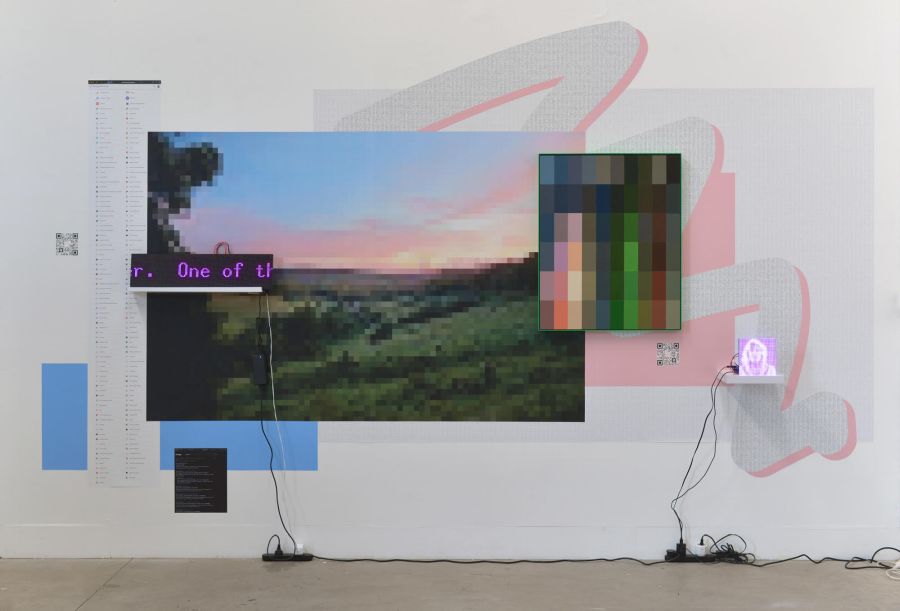
Beyer says she is currently having a lot of fun using AI in a similar way to surrealist automatism or automatic writing.
‘It produces a string of words that when joined together don’t really make much sense, but it can also be thoughtful and very funny. So, on a number of levels, AI is my creative collaborator and serves to augment my imagination,’ she says.
Artist Daniel Crooks on seeking the perfect AI-assistant
Daniel Crooks – best known for his screen and installation works – says he’s ‘a total sci-fi optimist in terms of AI solving the world’s really big problems’. But he is concerned about what he sees as an AI-related race to the bottom ‘where we totally screw ourselves before we get to the good stuff’.
He’s also worried that AI may lead to the collapse of any sense of shared objective truth and what Adam Curtis calls HyperNormalisation – a world where ‘nobody believes anything, and the baddies do whatever they want’.
Read: I, Artist
When it comes to his art practice, Crooks admits that, in fact, he’s been yearning for his own AI-assistant for years. ‘But the kind of AI assistant I want is not the Chat GPT/Midjourney “make up some stuff for me” kind. It’s more the “learn to be me” kind,’ he says.
‘I could trust it to do a task pretty much exactly as I would have done it, just a trillion times faster,’ he continues.
‘On a pedestrian level it would mean no more of the really boring admin stuff. But on another level, the assistant would be able to trawl through massive amounts of footage searching for those highly nuanced connections, and then come back to me with a set of suggestions or possibilities to further explore.
‘That’s a job that would literally take me years.’
At the same time, Crooks says that he would never want AI to do all the work. ‘I really like making things,’ he says. ‘Be that with my hands, or with software on a computer, and I find it hard to imagine myself experiencing that level of fulfilment by only ever “discussing” my projects with my ultra-maker-editor-coder-fabricator-assistant,’ he concludes.
A final thought from playwright Alana Valentine
For esteemed Australian playwright Alana Valentine – who is currently in creative development for her new work My Beautiful Man – AI may be a force that increases our appreciation for art and live theatre with its potential for spontaneity and disruption.
She tells ArtsHub, ‘I think the so-called “perfection” of AI and what it can create – the dead hand of form without spirit – may well show us what it is that we really value about the art that human beings make.’
Evidently, her recent experiences in the studio have only served to clarify this idea.
‘It has been my honour to spend the past week with six profoundly gifted singers and performers. And after all the superb technical work we are doing in rehearsal, I think what actually shines through the most in performance is the heart of the performer.
‘It’s less about getting all the notes and words exactly right – though of course I want that too. But for me, it’s more about the fact that the beautiful emotional sound is coming out of that body, those lungs, that person in front of me. That’s why we go to the theatre.’
But isn’t Valentine also worried that as a writer, AI may soon put her out of a job?
‘Well, yes, as a playwright, I could say that AI will be the bane of the future – the friend who betrays, the fast food, cookie cutter culture of decadent distraction,’ she says.
‘But as an artist, I dare to hope that in the face of AI perfectionism, human creativity will remain a tremendously valued thing – just perhaps in different ways than it is now.’
